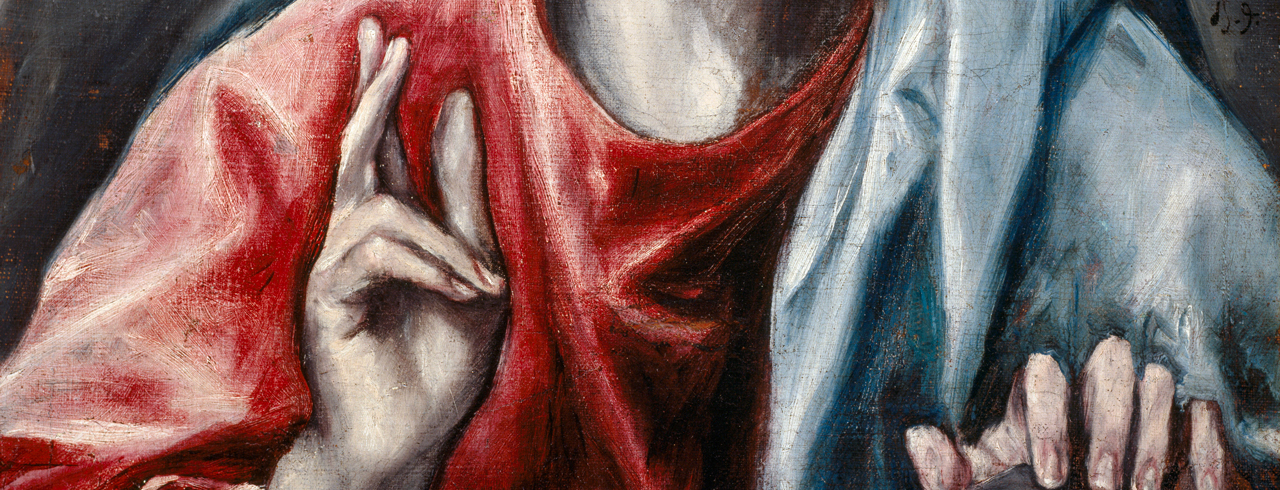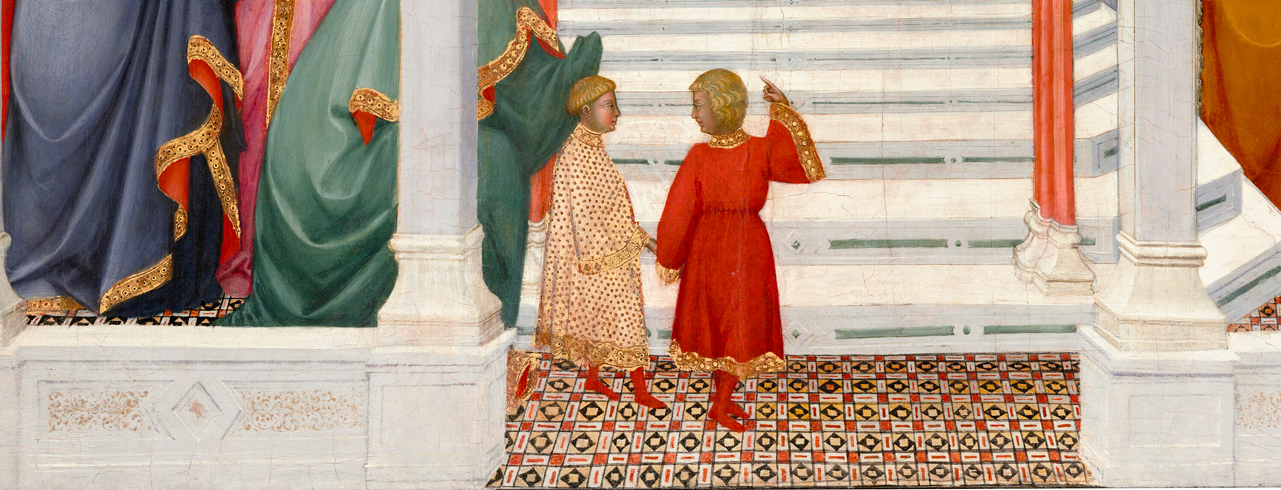-
Discover Magnificat
All you need to know about Magnificat
-
Subscribe to Magnificat
Subscribe, renew or offer a subscription

Everything Lives in Him
Pierre-Marie Dumont

The Presentation of the Virgin in the Temple (c. 1398–1399)
Paolo di Giovanni Fei (c. 1335/1345–1411)
Many great works of literature begin in medias res: a writer often does not begin at the beginning—the events that set a story in motion—but “hastens the outcome, and snatches the reader into the midst of the action” (Horace, Ars poetica). The Gospels are no exception. Mark begins suddenly with the appearance of John the Baptist preaching a baptism of repentance for the forgiveness of sins. Luke, who intends to write an orderly account of the things which have been accomplished among us (Lk 1:1, 3), begins with the events leading to the births of John the Baptist and his cousin Jesus. Matthew opens his Gospel with the genealogy of Jesus Christ, but begins with Abraham rather than all the way back with Adam. John alone begins at the beginning, with the Word who was with God and was God, but this is a beginning which is without beginning or end.
Early Christians cherished the fourfold Gospel as the word that comes forth from the mouth of God (Dt 8:3), but curiosity about the many other things that Jesus did (Jn 21:25) left much room for the imagination. Early Christians were particularly intrigued by the early life of the Blessed Virgin Mary. In the Gospel of Luke, we first encounter Mary in medias res: In the sixth month, the angel Gabriel was sent from God to a town of Galilee called Nazareth, to a virgin betrothed to a man named Joseph, of the house of David, and the virgin’s name was Mary (Lk 1:26-27).
How old was Mary? Where had she come from? How had she become betrothed to Joseph? What was she doing before the Gospel begins? Most importantly, how had she been prepared to give her great Fiat to the Annunciation? The sacred author, in his wisdom, decided not to answer these questions, interesting though they may be. Nevertheless, the artistic tradition of the Church, building on early traditions and non-canonical stories about Jesus and Mary, offers much food for thought as we reflect on the mother of the Bread of Angels.
The Sienese painter Paolo di Giovanni Fei gives a vivid portrayal of the Presentation of the Virgin in the Temple, drawing on early non-canonical stories of Mary’s childhood. According to the 2nd–3rd century Protoevangelium of James, Mary was brought to the Temple in Jerusalem at the age of three by her parents Joachim and Anne in fulfilment of a vow they had made to dedicate their child to God.
In Paolo’s painting, a rather mature-looking three-year-old stands serenely on the top step of an elevated platform. Four figures are endowed with halos. Joachim and Anne stand to our left, reassuring their daughter with encouraging gestures. The haloed man on the top step is Zechariah, the future father of Jesus’ cousin John the Baptist. Although the Protoevangelium only names Zechariah in a later passage, when Mary is twelve years old, the priest’s halo is an indication that Paolo is following an artistic tradition which links Zechariah to the reception of Mary in the temple. Paolo’s depiction of Zechariah reaching out to embrace the child recalls the description of Mary’s reception in the Protoevangelium: “And the priest took her and kissed her and blessed her, saying, ‘The Lord has magnified your name among all generations….’ And he placed her on the third step of the altar, and the Lord God put grace upon her and she danced with her feet, and the whole house of Israel loved her.”
While apocryphal sources such as the Gospel of Pseudo-Matthew emphasise Mary’s eagerness to enter the temple, claiming that “she did not look back at all; nor did she, as children are wont to do, seek for her parents,” Paolo offers a more nuanced portrayal of Mary’s emotions on this occasion. Her gaze rests midway between her parents and her uncle. Mary’s posture denotes both firmness of will and resignation to the will of the Lord. Even her garments hint at her intermediary role—not fully gold like those of the priest, and not merely lined with gold like those of her parents. Mary is being prepared to accept her future role as the Mother of the Mediator between God and Men. As the Protoevangelium puts it, “Mary was in the Temple of the Lord nurtured like a dove and received food from the hand of an angel.” The one who would knead the bread of angels in her womb (to borrow an image from Paolo’s contemporary Saint Catherine of Siena) and offer the sacrifice of a pair of turtledoves to consecrate her offspring to the Lord (cf. Lk 2:22-24) was fittingly provided for while preparing for these tasks.
Paolo di Giovanni Fei’s painting was made at the end of the 14th century to adorn the altar of the chapel of Saint Peter at the Duomo of Siena. Although the feast of the Presentation in the Temple had long been celebrated in the East, it was only widely introduced to the West beginning in 1372, just a few decades before the subject was chosen for this painting. The feast was spread through the influence of Philippe de Mézières (c. 1327–1405), who sought to restore unity with the Greek Orthodox and thought that the introduction of this Eastern feast in the West would favour this goal. A few years later, in 1389, Pope Urban VI introduced the feast of the Visitation of Mary in a similar effort to end the Western Schism through the intercession of the Blessed Mother. In both cases, the feasts quickly became beloved -occasions of the liturgical year, inviting the intercession of Mary and encouraging Christians to imitate her in -singlehearted devotion to God and neighbour. Like all the feasts of the liturgy, they invite us to place ourselves in -medias res, meditating on the One who has done, and is doing, great things for us.
Father Innocent Smith, O.P.
Dominican friar of the Province of Saint Joseph and professor of liturgical studies
at the Dominican House of Studies in Washington, DC.




A painter of icons from the Island of Crete, El Greco (1541–1614) arrived in Venice at the age of twenty-seven and grew close to Tintoretto (c. 1518–1594), whose style he adopted. At the age of thirty-six, he settled in Spain, where he then rose like the dazzling sun of the Spanish Golden Age.
The painting that adorns the cover of this issue of Magnificat shows what a special kind of genius El Greco was. In it we can see the exaltation the painter obtained by giving his subjects the undulating form of a fiery flame, while noticeably lengthening the natural proportions. In this exaltation, the secrets of El Greco’s art hold in three words: life, light, and colour.
Life. El Greco treated his drawing like the rough draft of a sketch. But he would repeat it several times by juxtaposing similar motifs that were almost invisibly staggered. This “animated drawing” creates a sensation of life and movement that is manifest in the work we are considering here.
Light. In the evening of his life, El Greco said: “All my life I have burned, all my life. Not in the fire, but in the light. I threw myself into its blaze.” Light—and not shadows, as is proper in sculpture and architecture—was the fundamental reality that structured his works. There is no sunlight in El Greco’s work. Only the light born from light conveys to the viewer the invisible aspect of the visible subject. Didn’t he often say: “I never leave home before six o’clock in the evening, for fear that the sun’s luminosity might darken my interior light”? Here, the Saviour of the world seems to have his own light within him. This light is strong, brilliant, to the point of whitening the flesh tones.
Colour. Cézanne said: “Colour is the point where our brain and the universe meet.” In the works of El Greco, it is the point where divinity becomes iridescent in humanity; it is the testimony of the diffraction of grace upon the palette of creation. How, technically, does an artist make this visible? By applying successive layers of a weak concentration of pigment on a white base: this makes the colour quite vibrant, alive, in movement. In this Salvator Mundi there is the additional effect of the daring juxtaposition of the madder-lacquer red of Christ’s tunic with the steel blue of his cloak.1
This Salvator Mundi 2, then—incorrectly called “Christ Blessing”—was painted around the year 1600, at the height of El Greco’s mature period. El Greco was inspired to paint it particularly because it repeats the theme of the icon of Christ called Pantocrator,3 which was popularised in the West in the 15th century to foster private devotion. In this half-length portrait, Christ is depicted life-sized, facing forward. His eyes meet those of the viewer, and he offers the opportunity for an almost personal meeting. Instead of the Gospel book, which appears on the icons beneath his right hand, he holds a crystal orb, which symbolises not only the Earth but the whole universe that lives in him:
For in him all things were created, in heaven and on earth,
Visible and invisible,
Whether thrones or dominions or principalities or authorities—
All things were created through him and for him.
He is before all things, and in him all things hold together. (Col 1:16-17)
With his right hand raised, Jesus Christ makes a gesture that is often interpreted as a blessing but in reality is the gesture of the Teacher, of the One who teaches all truth because he is the very Word of God. It is at the same time the gesture of a Supreme Judge. Finally, this gesture constitutes the living sceptre of the One who will reign for ever and ever. In the East, the thumb, index, and middle fingers are raised, representing the Three Persons of the Holy Trinity, whereas the ring finger and the little finger—lowered and joined—symbolise respectively the divine nature and the human nature that are united in Jesus. Finally, with the palm of the hand, these two fingers form a heart which reminds us the Christ Jesus is king of a Kingdom where Love reigns.
Isn’t it true, as El Greco said, that “the language of art is of celestial origin and can be understood only by the elect”?
-------------------------
1 This same blue and this same juxtaposition were later Picasso’s source of inspiration for his Blue Period.
2 Our Scottish readers should note that they can track down this painting at the National Gallery in Edinburgh.
Pierre-Marie Dumont
Salvator Mundi (c. 1600), El Greco (1541–1614), National Gallery of Scotland, Edinburgh.
© Dist. GP-RMN / Scottish National Gallery Photographic Department.